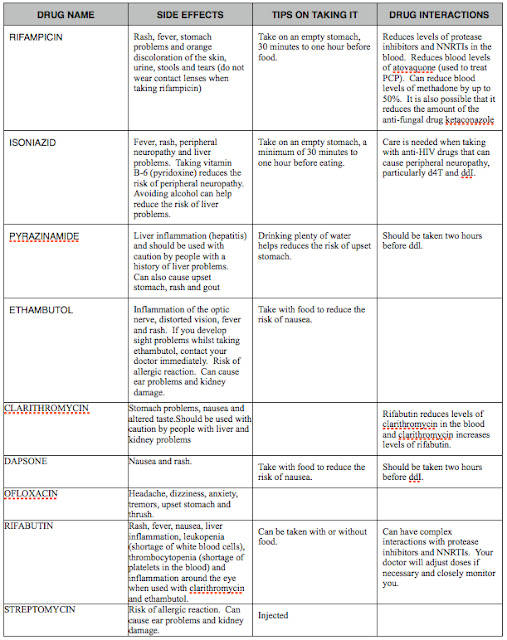TB Meds, HIV and ARV's
Posted by Pozziepinoy on 8:17 AM
 What is TB?
What is TB?TB is a disease caused by the bacteria known as Mycobacterium tuberculosis. TB most often infects the lungs, but can infect any part of the body. TB infection is classified in one of two ways:
Latent TB TB infection has occurred but is not causing illness or symptoms and is not contagious.
Active TB The lungs have become infected; referred to as pulmonary TB and the infection is causing TB symptoms such as cough, blood tinged sputum, night sweats and fever. Active TB will also show up on a chest x-ray. If a person has active TB, he or she can spread the TB infection to other people.
Can TB Infect Organs Other Than the Lungs?
Yes. While active TB affects primarily the lungs, it is possible to have TB infections of other parts of the body. The kidneys, abdomen, spine, and skin can all be infected by TB. Keep in mind that if person's TB infection is not in the lungs or throat, the infection usually can't be spread to other people.
How is TB Spread?
TB is spread from person to person via microscopic water droplets containing TB bacteria. When a person with active TB cough, sneezes, or exhales, infected water droplets are released into the air. Infection occurs when other people inhale these droplets. Active TB can happen at the time of exposure or can be the result of a reactivated latent infection. A person cannot get TB from shaking hands, sitting on a toilet seat, or sharing dishes or utensils.
Why is TB important for people with HIV?
Active TB usually occurs in people with a weakened immune system; including those people living with HIV. A weakened immune system allows the TB bacteria to multiply unchecked, causing illness. TB can make HIV multiply faster, lower the CD4 count, and make HIV disease worse. HIV+ patients with tuberculosis respond well to antituberculosis therapy. The treatment of HIV-related tuberculosis requires close monitoring because of frequent drug toxicities, possible drug-drug interactions, and paradoxical reactions. A combination of 4 anti TB drugs Pyrazinamide 400 mg, Rifampicin 150 mg, Ethambutol HCl 275 mg, Isoniazid (INH) 75 mg is frequently used but some of these drugs may have to be substituted with others of the same class depending on the ARV that is being taken at the time. Sometimes the ARV will have to be switched as well. Your HIV Medical Specialist working with a TB specialist are the ones who are able to make that decision working in concert with you.
Drug-Drug Interactions
Successful therapy for tuberculosis requires that HIV-infected individuals take antituberculosis drugs for a minimum of 6 months, in addition to potentially large numbers of other medications. Certain antituberculosis drugs may interact adversely with medications commonly used by HIV-infected individuals. TB should usually be cured first before ART is started. However, this may not be possible if CD4 cell counts are low. Understanding these drug-drug interactions can prevent drug toxicity and possible treatment failures. Many anti-HIV drugs and anti-TB drugs can work well and safely together. However, as mentioned above, there can be interactions. It is not recommended to use certain anti-TB and anti-HIV drugs together and sometimes it is necessary to adjust the dose of one or the other. Because of these interactions it is very important that your doctor is skilled in the treatment of both TB and HIV or those specialists in both those fields are working closely together. If you are concerned about your treatment, or have any questions, ask your HIV Medical Specialist or TB Specialist to spend some time explaining your treatment to you.
Anti TB Drugs and ARV side effects.
Always consult your HIV Medical Specialist and other specialists before altering your ARV or TB regimen in any way, or before undertaking any changes, or beginning any medication or change in lifestyle including diet and exercise.
Please click these relevant links:
1. Discussion: OI's
2. On Tuberculosis and Hepatitis
3. Painful Feet
4. Prophylaxis with Low CD4
I hope readers have found this post helpful.
International Contributor
"WE ARE ALL IN THIS TOGETHER.
NO PLHIV is alone with his or her struggle with HIV!"
-Pozziepinoy-
© Copyright. All Rights Reserved by Pozziepinoy 2012
Credits:
Tags: HIV Manila, HIV Philippines, AIDS Manila, AIDS Philippines, HIV/AIDS Manila, HIV/AIDS Philippines



